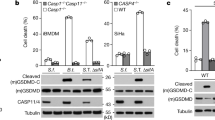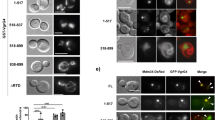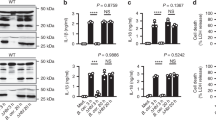Abstract
Many bacterial pathogens can enter various host cells and then survive intracellularly, transiently evade humoral immunity, and further disseminate to other cells and tissues. When bacteria enter host cells and replicate intracellularly, the host cells sense the invading bacteria as damage-associated molecular patterns (DAMPs) and pathogen-associated molecular patterns (PAMPs) by way of various pattern recognition receptors. As a result, the host cells induce alarm signals that activate the innate immune system1. Therefore, bacteria must modulate host inflammatory signalling and dampen these alarm signals2,3,4. How pathogens do this after invading epithelial cells remains unclear, however. Here we show that OspI, a Shigella flexneri effector encoded by ORF169b on the large plasmid and delivered by the type ΙΙΙ secretion system, dampens acute inflammatory responses during bacterial invasion by suppressing the tumour-necrosis factor (TNF)-receptor-associated factor 6 (TRAF6)-mediated signalling pathway. OspI is a glutamine deamidase that selectively deamidates the glutamine residue at position 100 in UBC13 to a glutamic acid residue. Consequently, the E2 ubiquitin-conjugating activity required for TRAF6 activation is inhibited, allowing S. flexneri OspI to modulate the diacylglycerol–CBM (CARD–BCL10–MALT1) complex–TRAF6–nuclear-factor-κB signalling pathway. We determined the 2.0 Å crystal structure of OspI, which contains a putative cysteine–histidine–aspartic acid catalytic triad. A mutational analysis showed this catalytic triad to be essential for the deamidation of UBC13. Our results suggest that S. flexneri inhibits acute inflammatory responses in the initial stage of infection by targeting the UBC13–TRAF6 complex.
This is a preview of subscription content, access via your institution
Access options
Subscribe to this journal
Receive 51 print issues and online access
$199.00 per year
only $3.90 per issue
Buy this article
- Purchase on Springer Link
- Instant access to full article PDF
Prices may be subject to local taxes which are calculated during checkout




Similar content being viewed by others
Accession codes
References
Takeuchi, O. & Akira, S. Pattern recognition receptors and inflammation. Cell 140, 805–820 (2010)
Kim, M. et al. Bacterial interactions with the host epithelium. Cell Host Microbe 8, 20–35 (2010)
Ashida, H., Ogawa, M., Kim, M., Mimuro, H. & Sasakawa, C. Bacteria and host interactions in the gut epithelial barrier. Nature Chem. Biol. 8, 36–45 (2011)
Taxman, D. J., Huang, M. T. & Ting, J. P. Inflammasome inhibition as a pathogenic stealth mechanism. Cell Host Microbe 8, 7–11 (2010)
Hilbi, H. Bacterial jailbreak sounds cellular alarm: phagosome membrane remnants trigger signaling. Cell Host Microbe 6, 102–104 (2009)
Dupont, N. et al. Shigella phagocytic vacuolar membrane remnants participate in the cellular response to pathogen invasion and are regulated by autophagy. Cell Host Microbe 6, 137–149 (2009)
Ashida, H. et al. Cell death and infection: a double-edged sword for host and pathogen survival. J. Cell Biol. 195, 931–942 (2011)
Mattoo, S., Lee, Y. M. & Dixon, J. E. Interactions of bacterial effector proteins with host proteins. Curr. Opin. Immunol. 19, 392–401 (2007)
Rahman, M. M. & McFadden, G. Modulation of NF-κB signalling by microbial pathogens. Nature Rev. Microbiol. 9, 291–306 (2011)
Girardin, S. E. et al. CARD4/Nod1 mediates NFκB and JNK activation by invasive Shigella flexneri. EMBO Rep. 2, 736–742 (2001)
Holden, N. S. et al. Phorbol ester-stimulated NF-κB-dependent transcription: roles for isoforms of novel protein kinase C. Cell. Signal. 20, 1338–1348 (2008)
Shahnazari, S. et al. A diacylglycerol-dependent signaling pathway contributes to regulation of antibacterial autophagy. Cell Host Microbe 8, 137–146 (2010)
Oancea, E., Teruel, M. N., Quest, A. F. & Meyer, T. Green fluorescent protein (GFP)-tagged cysteine-rich domains from protein kinase C as fluorescent indicators for diacylglycerol signaling in living cells. J. Cell Biol. 140, 485–498 (1998)
Rawlings, D. J., Sommer, K. & Moreno-Garcia, M. E. The CARMA1 signalosome links the signalling machinery of adaptive and innate immunity in lymphocytes. Nature Rev. Immunol. 6, 799–812 (2006)
Shao, F., Merritt, P. M., Bao, Z., Innes, R. W. & Dixon, J. E. A Yersinia effector and a Pseudomonas avirulence protein define a family of cysteine proteases functioning in bacterial pathogenesis. Cell 109, 575–588 (2002)
Zhu, M., Shao, F., Innes, R. W., Dixon, J. E. & Xu, Z. The crystal structure of Pseudomonas avirulence protein AvrPphB: a papain-like fold with a distinct substrate-binding site. Proc. Natl Acad. Sci. USA 101, 302–307 (2004)
Crow, A. et al. Crystal structures of Cif from bacterial pathogens Photorhabdus luminescens and Burkholderia pseudomallei. PLoS ONE 4, e5582 (2009)
Sinclair, J. C., Sandy, J., Delgoda, R., Sim, E. & Noble, M. E. Structure of arylamine N-acetyltransferase reveals a catalytic triad. Nature Struct. Biol. 7, 560–564 (2000)
Kitadokoro, K. et al. Crystal structures reveal a thiol protease-like catalytic triad in the C-terminal region of Pasteurella multocida toxin. Proc. Natl Acad. Sci. USA 104, 5139–5144 (2007)
Orth, J. H. et al. Pasteurella multocida toxin activation of heterotrimeric G proteins by deamidation. Proc. Natl Acad. Sci. USA 106, 7179–7184 (2009)
Wang, Y. et al. MMDB: annotating protein sequences with Entrez’s 3D-structure database. Nucleic Acids Res. 35, D298–D300 (2007)
Buetow, L., Flatau, G., Chiu, K., Boquet, P. & Ghosh, P. Structure of the Rho-activating domain of Escherichia coli cytotoxic necrotizing factor 1. Nature Struct. Biol. 8, 584–588 (2001)
Wang, C. et al. TAK1 is a ubiquitin-dependent kinase of MKK and IKK. Nature 412, 346–351 (2001)
Deng, L. et al. Activation of the IκB kinase complex by TRAF6 requires a dimeric ubiquitin-conjugating enzyme complex and a unique polyubiquitin chain. Cell 103, 351–361 (2000)
Lamothe, B. et al. Site-specific Lys-63-linked tumor necrosis factor receptor-associated factor 6 auto-ubiquitination is a critical determinant of IκB kinase activation. J. Biol. Chem. 282, 4102–4112 (2007)
Fukushima, T. et al. Ubiquitin-conjugating enzyme Ubc13 is a critical component of TNF receptor-associated factor (TRAF)-mediated inflammatory responses. Proc. Natl Acad. Sci. USA 104, 6371–6376 (2007)
Yin, Q. et al. E2 interaction and dimerization in the crystal structure of TRAF6. Nature Struct. Mol. Biol. 16, 658–666 (2009)
Datsenko, K. A. & Wanner, B. L. One-step inactivation of chromosomal genes in Escherichia coli K-12 using PCR products. Proc. Natl Acad. Sci. USA 97, 6640–6645 (2000)
Ashida, H. et al. A bacterial E3 ubiquitin ligase IpaH9.8 targets NEMO/IKKγ to dampen the host NF-κB-mediated inflammatory response. Nature Cell Biol. 12, 66–73 (2010)
Sasakawa, C. et al. Molecular alteration of the 140-megadalton plasmid associated with loss of virulence and Congo red binding activity in Shigella flexneri. Infect. Immun. 51, 470–475 (1986)
Sasakawa, C., Makino, S., Kamata, K. & Yoshikawa, M. Isolation, characterization, and mapping of Tn5 insertions into the 140-megadalton invasion plasmid defective in the mouse Sereny test in Shigella flexneri 2a. Infect. Immun. 54, 32–36 (1986)
Takaesu, G. et al. TAB2, a novel adaptor protein, mediates activation of TAK1 MAPKKK by linking TAK1 to TRAF6 in the IL-1 signal transduction pathway. Mol. Cell 5, 649–658 (2000)
Ishida, T. et al. Identification of TRAF6, a novel tumor necrosis factor receptor-associated factor protein that mediates signaling from an amino-terminal domain of the CD40 cytoplasmic region. J. Biol. Chem. 271, 28745–28748 (1996)
Kim, M. et al. Bacteria hijack integrin-linked kinase to stabilize focal adhesions and block cell detachment. Nature 459, 578–582 (2009)
Otwinowski, Z. M. W. Processing of X-ray diffraction data collected in oscillation mode. Methods Enzymol. 276, 307–326 (1997)
Collaborative Computational Project, 4. The CCP4 suite: programs for protein crystallography. Acta Crystallogr. D 50, 760–763 (1994)
Schneider, T. R. & Sheldrick, G. M. Substructure solution with SHELXD. Acta Crystallogr. D 58, 1772–1779 (2002)
Morris, R. J., Perrakis, A. & Lamzin, V. S. ARP/wARP and automatic interpretation of protein electron density maps. Methods Enzymol. 374, 229–244 (2003)
Emsley, P. & Cowtan, K. Coot: model-building tools for molecular graphics. Acta Crystallogr. D 60, 2126–2132 (2004)
Brunger, A. T. Version 1.2 of the Crystallography and NMR system. Nature Protocols 2, 2728–2733 (2007)
McNicholas, S., Potterton, E., Wilson, K. S. & Noble, M. E. Presenting your structures: the CCP4mg molecular-graphics software. Acta Crystallogr. D 67, 386–394 (2011)
DeLano, W. L. Unraveling hot spots in binding interfaces: progress and challenges. Curr. Opin. Struct. Biol. 12, 14–20 (2002)
Kobayashi, N. et al. Segregation of TRAF6-mediated signaling pathways clarifies its role in osteoclastogenesis. EMBO J. 20, 1271–1280 (2001)
Morikawa, H. et al. The bacterial effector Cif interferes with SCF ubiquitin ligase function by inhibiting deneddylation of Cullin1. Biochem. Biophys. Res. Commun. 401, 268–274 (2010)
Parsot, C., Menard, R., Gounon, P. & Sansonetti, P. J. Enhanced secretion through the Shigella flexneri Mxi-Spa translocon leads to assembly of extracellular proteins into macromolecular structures. Mol. Microbiol. 16, 291–300 (1995)
Acknowledgements
We thank H. Fukuda for matrix-assisted laser desorption/ionization–time of flight (MALDI–TOF) analysis. We thank the members of the Sasakawa laboratory for their advice. We are grateful to R. Whittier for critical reading of the manuscript. Diffraction data were collected at the Osaka University beamline BL44XU at SPring-8. This work was supported by a Grant-in-Aid for Scientific Research on Innovative Areas (23121525 (T.M.)), a Grant-in-Aid for Specially Promoted Research (23000012 (C.S.)), a Grant-in Aid for Young Scientists (A) (23689027 (M.K.)), several Grants-in-Aid for Young Scientists (B) (23790471 (M.O.), 23790472 (H.A.) and 22790403 (T.S.)), a Grant-in-Aid for Scientific Research (B) (23390102 (H.M.)), a Grant-in-Aid for Challenging Exploratory Research (23659220 (H.M.)), a Grant-in-Aid for Scientific Research on Priority Areas (18073003 (C.S.)) and the Japan Initiative for Global Research Network on Infectious Diseases (C.S.). Part of this work was supported by grants from the Naito Foundation (M.K. and H.M.), the Waksman Foundation of Japan (M.O.), the Yakult Bio-Science Foundation (M.O.), the Yakult Central Institute (C.S.) and The Hayashi Memorial Foundation for Female Natural Scientists (M.K.).
Author information
Authors and Affiliations
Contributions
T.S. and T.M. designed and performed the experiments. M.K., H.M., M.S., H.A., A.O., T. Kobayashi and M.O. assisted with the experiments. J.G., Y.S. and J.I.I. gave advice regarding the design of the experiments and provided TRAF6 materials. T. Koyama and S.N. made antibodies. A.O. made the ΔospI mutant. C.S. and T.M. wrote the paper.
Corresponding authors
Ethics declarations
Competing interests
The authors declare no competing financial interests.
Additional information
Atomic coordinates and structure factors for the OspI structure have been deposited in the PDB under ID 3B21.
Supplementary information
Supplementary Information
This file contains Supplementary Figures 1-15 and Supplementary Table 1. (PDF 16996 kb)
Rights and permissions
About this article
Cite this article
Sanada, T., Kim, M., Mimuro, H. et al. The Shigella flexneri effector OspI deamidates UBC13 to dampen the inflammatory response. Nature 483, 623–626 (2012). https://doi.org/10.1038/nature10894
Received:
Accepted:
Published:
Issue Date:
DOI: https://doi.org/10.1038/nature10894
Comments
By submitting a comment you agree to abide by our Terms and Community Guidelines. If you find something abusive or that does not comply with our terms or guidelines please flag it as inappropriate.



